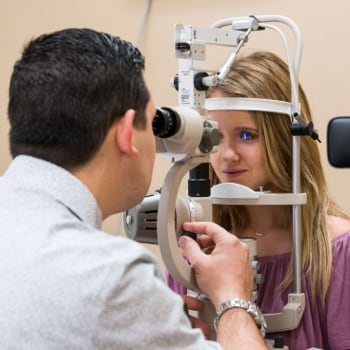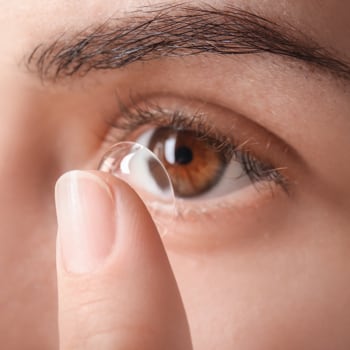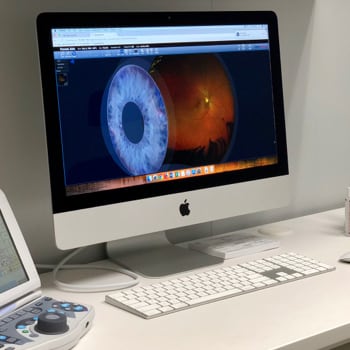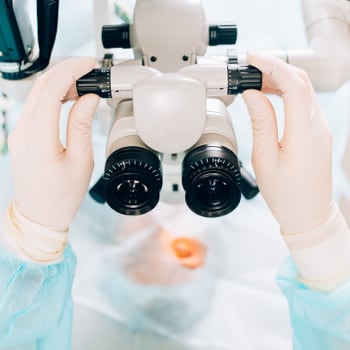When you’re considering LASIK surgery, it’s worth thinking about what comes after. You may be excited to return to your normal activities and start enjoying your improved vision as soon as possible, but when will that be?
You should be able to see immediately after LASIK, but it usually takes 2–3 months for the eye to heal. Several factors can affect your recovery time, so your optometrist will likely recommend follow-up eye exams to monitor your progress.
What is LASIK?
For those who wear corrective lenses, the idea of waking up in the morning and seeing the world clearly without glasses or contacts can be life-changing. That’s where LASIK eye surgery comes in.
LASIK stands for laser-assisted in situ keratomileusis and is designed to correct nearsightedness, farsightedness, and astigmatism. LASIK is a surgical procedure that uses a laser to reshape the cornea, the clear part of the eye that focuses light onto the retina at the back of the eye.
To do this, the surgeon creates a flap in the cornea, which is then lifted to expose the underlying tissue. The surgeon then uses the laser to reshape the tissue, which changes the cornea’s curvature. Once the cornea is reshaped, the flap is replaced and allowed to heal naturally over time. LASIK is a relatively quick procedure, typically taking less than 30 minutes.
Am I A Good Candidate for LASIK?
A good candidate for LASIK should:
- Be over 21
- Have a stable eye prescription
- Have thick enough corneas
- Be nearsighted or farsighted
If you’re unsure whether or not LASIK could work for you, your optometrist can take you through the requirements.
What Happens During a Consultation?
A LASIK consultation is a chance to look for the signs that indicate you may be a good candidate for surgery and check for any red flags. The exam may include tests like measuring your cornea thickness, mapping your corneal shape, and checking for any underlying eye conditions.
Your optometrist may discuss your medical history, including any relevant conditions you have or medications you are taking. This is important because certain medical conditions, such as severe dry eyes or uncontrolled diabetes, may affect your suitability for LASIK. Your doctor may also want to discuss any eye-related issues you’ve had in the past and how they could impact your LASIK results.
The consultation can also help you decide if laser surgery is the right choice for your lifestyle. Your optometrist can discuss in detail what the procedure entails, what to expect before, during, and after the surgery, and what kind of results you can expect.
We want to understand your expectations and desired outcomes from the surgery, as well as address any questions or concerns you may have. It’s important to be upfront and honest with us about what you hope to achieve from LASIK. If there are specific concerns you have about the procedure, or if you’re hoping for a specific outcome, we can help manage your expectations and decide if LASIK is the right choice for you.
What to Expect After LASIK
As your eyes heal, you can expect different effects.
Immediately After LASIK
Your LASIK recovery begins the moment the procedure is complete. You may be given eye drops and protective shields to wear over your eyes. It’s essential to follow your surgeon’s instructions carefully during the first few days and avoid rubbing or touching your eyes. It’s also crucial to take it easy and rest your eyes as much as possible during this period.
Most patients can resume normal activities as early as the day of the procedure, but it’s recommended to avoid strenuous activity, swimming, or applying makeup for at least a week, if not more.
The First Few Days After LASIK
The first few days are critical for your LASIK recovery. During this time, you may experience mild discomfort, irritation, and sensitivity to light. Your vision may also be hazy or blurry, and you may notice halos or glare around lights. These are all normal side effects that usually subside within a few days.
Be sure to attend all post-operative appointments with your management team and follow our instructions on how to care for your eyes. You should continue to avoid rubbing or touching your eyes, as this can cause complications and delay your recovery time.
The First Few Weeks After LASIK
The first few weeks after LASIK are when you start to notice significant improvements in your vision. Your eyes are still healing during this period, and you may experience:
- Fluctuations in your visual acuity
- Blurry vision
- Dry eyes
- Glares or halos around lights
You may want to avoid driving until your vision has stabilized and you’ve been cleared by your management team. Be patient during this time and avoid over-exerting yourself.
The First Few Months After LASIK
Your eyes should heal within 2–3 months, but it could take 6 months before your vision fully stabilizes. Your age, overall health, and the intensity of the previous refractive error can all affect how long it takes. Until then, your vision should be getting clearer as you recover.
During this time, you may still experience minor side effects, but they should gradually subside over time. Keep attending all post-operative appointments so your management team can check:
- If your vision has improved
- How your eyes are healing
- If you’re experiencing side effects
Take your time and you could be enjoying clear vision before you know it!
Explore A World of Clear Vision
So, how long does it take to recover from LASIK? The answer is that it varies depending on you and factors such as age, overall health, and the severity of your refractive error. However, on average, most people can expect to recover within a few months.
Getting LASIK can be a life-changing experience, but it’s important to go through the consultation process before deciding to move forward. That’s why Great Hills Eye Care offers LASIK co-management, to help you understand your options and manage your pre and post-surgical care. Book your appointment today and explore our trusted network of LASIK surgeons in the Austin area.














